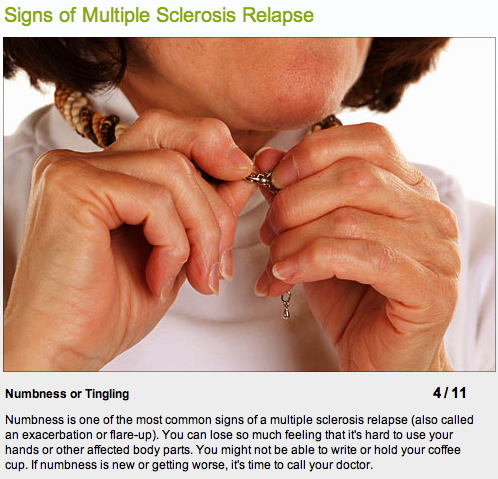
In some ways, each person with multiple sclerosis lives with a different illness. Although nerve damage is always involved, the pattern is unique for each individual who has MS.
Although individual experiences with MS vary widely, doctors and researchers have identified several major types of MS. The categories are important. That's because they help predict disease severity -- and response to treatment.
Primary Progressive Multiple Sclerosis
In primary progressive multiple sclerosis, symptoms continually worsen from the time of diagnosis. There are no well-defined attacks. And there is little or no recovery. Between 10% and 15% of people with MS have primary progressive MS.
Several aspects of primary progressive MS distinguish it from other types of MS:
- People with primary progressive MS are usually older at the time of diagnosis -- an average age of 40.
- Roughly equal numbers of men and women develop primary progressive MS. In other types of MS, women outnumber men three to one.
- Primary progressive MS usually leads to disability earlier than relapsing-remitting MS (see below).
- Perhaps the most upsetting difference in primary progressive MS is its poor response to treatment. So far, no treatments have been shown to help, although studies are ongoing.
Relapsing-Remitting Multiple Sclerosis
Most people with multiple sclerosis -- around 90% -- have the relapsing-remitting type. Symptoms first affect most people in their early 20s. After that, there are periodic attacks (relapses), followed by partial or complete recovery (remissions).
The pattern of nerves affected, severity of attacks, degree of recovery, and time between relapses all vary widely from person to person.
Eventually, most people with relapsing-remitting MS will enter a secondary progressive phase of MS.
Secondary Progressive Multiple Sclerosis
After living with relapsing-remitting MS for many years, most people will develop secondary progressive MS. In this type of MS, symptoms begin a steady march, without relapses or remissions. (In this way, secondary progressive MS is like primary progressive MS.) The transition typically occurs between 10 and 20 years after the diagnosis of relapsing-remitting MS.
It's unclear why the disease makes the transformation from relapsing-remitting to secondary progressive MS. A few things are known about the process:
- The older a person is at original diagnosis, the shorter the time for the disease to become secondary progressive.
- People with incomplete recovery from initial relapses generally convert to secondary progressive MS sooner than those who recover completely.
- The process of ongoing nerve damage changes. After the transformation, there's less inflammation, and more slow degeneration of nerves.
Secondary progressive MS is challenging to treat -- and to live with. Treatments are moderately effective at best. Progression occurs at a different rate in each person and generally leads to some disability.
Progressive Relapsing Multiple Sclerosis
Progressive relapsing multiple sclerosis is the least common form of the disease. Relapses or attacks occur periodically. However, symptoms continue and are progressive in between relapses.
Progressive relapsing MS is rare enough that little is known about it. Probably around 5% of people with multiple sclerosis have this form. Progressive relapsing MS seems to be similar to primary progressive MS in many ways.
What Causes Multiple Sclerosis?
No one knows what causes multiple sclerosis. Tantalizing clues have sparked research in many areas, but no definite answers. Some theories have included:
- Geography. People in the northern U.S. develop MS more often than those in the warmer south. Research into vitamin D and sunlight as protective factors is ongoing.
- Smoking. Tobacco may increase the risk slightly. But it's not the whole story.
- Genetics. Genes do play a role. If an identical twin has MS, the other twin has a 20% to 40% chance of developing it as well. Siblings have a 3% to 5% chance if a brother or sister is affected.
- Vaccines. Extensive research has essentially ruled out vaccines as a cause of MS.
Multiple sclerosis is probably an autoimmune disease. Like lupus or rheumatoid arthritis, the body creates antibodies against itself, causing damage. In MS, the damage occurs in the lining, or myelin, of nerves.
How Is Multiple Sclerosis Diagnosed?
Multiple sclerosis is generally diagnosed after a person has experienced troublesome symptoms related to nerve damage. Vision loss, weakness, and loss of sensation are common complaints.
The most common tests used to diagnose MS are scans of the brain and spinal cord with magnetic resonance imaging (MRI) and lumbar puncture or a spinal tap.
Unfortunately, the time between the first appearance of symptoms and diagnosis of MS can be prolonged. Studies show that because symptoms are often low-grade or vague, doctors may miss the diagnosis.
Even when symptoms are definitely consistent with MS, the diagnosis still can't be made right away. This is because, by definition, multiple sclerosis is a long-term illness. After the first symptoms, there's an often frightening and frustrating period of waiting until more symptoms occur and the diagnosis becomes clear.
七種多發性硬化症的症狀:













 留言列表
留言列表
 線上藥物查詢
線上藥物查詢 